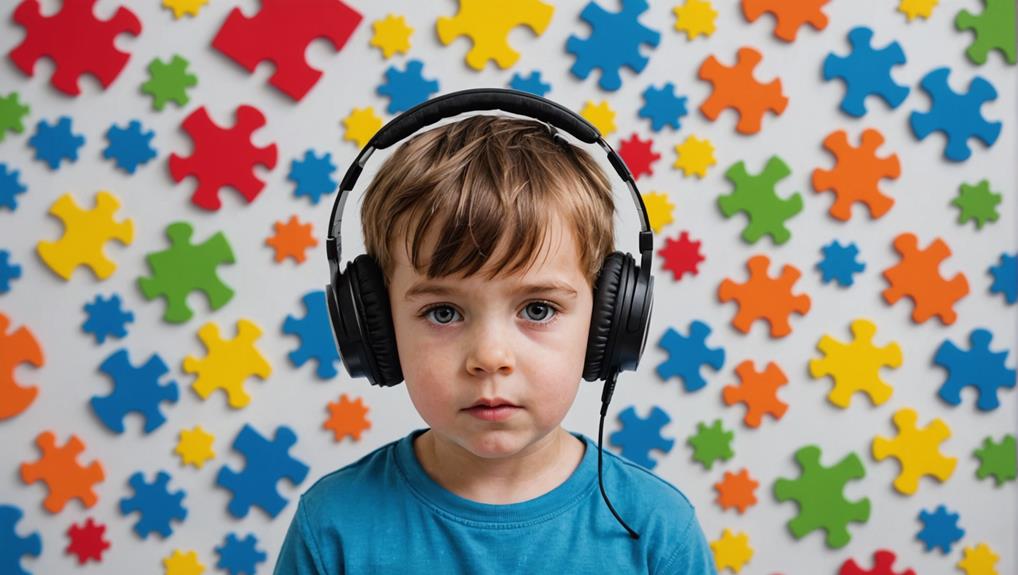Recognizing the early signs of autism in toddlers can be a challenging task for parents, given the array of behaviors involved. Key indicators, such as limited speech development, non-verbal communication challenges, repetitive actions, and uncommon social interactions, can provide critical insights. While dispelling myths and misconceptions about these signs is crucial, it is even more essential to cultivate an understanding of how these signs present themselves. By doing so, parents can guarantee timely interventions and support, ultimately shaping their children’s developmental journey and enhancing their overall well-being. What do these signs look like, and how do they manifest in everyday life?
Key Takeaways
- Toddlers with autism may have limited speech, difficulty with non-verbal communication, or a lack of interest in social interactions.
- Behavioral signs in toddlers, such as repetitive actions, intense focus on specific objects, and toe walking, can indicate autism.
- Sensory sensitivities such as aversion to specific sounds or textures are common early signs of autism.
- Deficits in joint attention, like not looking back and forth between an object and another person, are often seen in children with autism.
- Observations of temperamental markers like fussiness or difficulty in soothing may also suggest a risk of ASD.
Understanding Autism Spectrum Disorder
Autism Spectrum Disorder (ASD) is a neurodevelopmental condition that poses significant obstacles to social communication and interaction. These disorders can notably impact a child’s development, appearing in various forms like repetitive behaviors, restricted interests, and verbal and nonverbal communication challenges. Significantly, some children with ASD may show delays in social skills, which include effective communication and cooperation.
For children with autism, the world can be a perplexing array of sensory experiences and social norms that may be overwhelming. Their distinct way of understanding and interacting with society can make their life challenging, but with empathetic support and guidance, they can navigate the world around them more successfully. Understanding how ASD can affect social interactions, mainly through potential social skills delays, is essential for their development.
Early diagnosis and intervention are vital in supporting children’s developmental progress on the spectrum. It allows professionals to provide tailored strategies that cater to their specific communication and social interaction needs. Recognizing the early signs of autism, such as limited speech, repetitive actions, and sensory sensitivities, enables parents and caregivers to seek the necessary help. By understanding the critical indicators of ASD, we can offer children the support they need to thrive. These are the initial steps towards fostering a more accepting world and understanding of the autism spectrum.
Developmental Milestones and Autism
Noticing anomalies in developmental milestones is often one of the earliest indicators of autism in toddlers. Developmental milestones include motor skills, language acquisition, social communication, and cognitive development. While variations exist in the timing of these milestones, significant deviations could be initial signs of autism.
Parents can use checklists and apps to track child development. These tools can highlight potential concerns that may warrant further professional consultation. However, it’s crucial to remember that a professional evaluation is vital for a formal autism diagnosis.
Recognizing these signs in infants with autism can lead to more timely and beneficial interventions. Some signs may even be noticeable before a child reaches their primary birthday, emphasizing the significance of early detection.
| Developmental Milestone | Standard Age Range | Potential Autism Indicator |
|---|---|---|
| Social Smile | Six weeks to 2 months | Lack of or infrequent smiling |
| Babbling | 6 to 9 months | Limited or lack of babbling |
| Pointing/Showing | 12 to 16 months | No pointing, showing, or other communicative gestures |
| Words | 12 to 16 months | Fewer than 15 words |
Informed, empathetic vigilance can make all the difference in early autism detection and intervention.
Identifying Early Signs of Autism

In identifying early signs of autism in toddlers, paying attention to specific behavioral indicators is essential. These can range from limited speech and atypical body movements to an intense focus on particular objects or activities. Some of these behaviors may stem from challenges in social skills, an area that can be improved with specific therapy strategies. Understanding these signs not only aids in early diagnosis but also underscores the significance of early intervention in influencing a child’s developmental trajectory. By recognizing these signs, parents can seek out interventions that can help improve their child’s social skills and overall quality of life.
Recognizing Behavioral Indicators
Understanding the behavioral signs of autism in toddlers is essential for early identification. Toddlers with autism may exhibit specific behavioral cues such as being excessively fussy, showing reduced eagerness to investigate, or pointing less at objects. These signs could be initial representations of a lack of social interaction skills, which can be improved through targeted strategies. Observing these early signs can significantly assist in recognizing a potential diagnosis.
Limited speech, toe walking, and difficulty following spoken instructions are key behavioral signs to watch for. Moreover, a strong interest in particular objects or activities, rather than a wide variety of interests, can also suggest autism. Sensitivity to sensory experiences like sounds, textures, or lights, a preference for routines, and resistance to change are other potential indicators. It’s important to note that these behaviors might be expressions of difficulty establishing and respecting personal boundaries, a vital social skill in children.
Toddlers at risk for autism may display delayed language development and limited interest in imaginative play, often choosing fixation on specific toys or activities instead. A lack of interest in social interactions is another common trait. Recognizing these behavioral signs early on can enable parents and caregivers to seek the necessary support and interventions, laying the groundwork for a child’s long-term development and well-being.
Importance of Early Intervention
The identification of early signs in toddlers potentially displaying autism spectrum disorder sets the stage for the timely implementation of interventions and support. Early intervention, which can involve play therapy techniques for social development, is vital in improving developmental outcomes, reducing developmental differences, and maximizing the child’s potential. The sooner the intervention commences, the better the child’s communication skills, social interaction abilities, and overall growth can be.
Recognizing key indicators such as repetitive behaviors, limited speech, toe walking, and sensitivity to sensory experiences is vital for early diagnosis. These signs, in conjunction with the child’s response to group therapy dynamics and social skill improvement, can indicate a deviation from typical development, thus necessitating further exploration. The significant contrast in development can be challenging for parents, but embracing the child’s individuality while seeking professional help can make a meaningful difference.
Parents should seek professional guidance for an official diagnosis when they notice potential signs of autism in their toddlers. Early diagnosis combined with early intervention can assist in addressing the child’s obstacles and enhancing their strengths. This proactive strategy will pave the way for the child’s more satisfying and productive life.
Role of Joint Attention in Autism
Joint attention plays a pivotal role in a child’s development in social communication. This involves a child looking back and forth between an object or event and another person, vital for nurturing social and communication skills. Effective communication is critical to this process, as it helps the child understand the importance of social interactions. However, children on the autism spectrum often exhibit delayed skills in this area, struggling with engaging in reciprocal social interaction.
Typically, developing children start using and understanding gestures at specific developmental stages, which is a crucial aspect of joint attention. However, children with Autism Spectrum Disorder (ASD) may exhibit differences in these pointing behaviors and responses. Recognizing the importance of empathy and emotional intelligence can help understand these differences. For instance, by the age of 12 months, most children can follow a parent’s pointing, but children with ASD may seem to ignore or not respond to such gestures.
Understanding the stages of joint attention in babies and toddlers can be instrumental in recognizing early signs of autism. This insight can lead to seeking appropriate interventions, ensuring the child’s development is supported best. Therefore, observing joint attention, among other social communication behaviors, is vital for parents and caregivers.
Language Delays in Autistic Toddlers

Navigating the maze of language development in toddlers can be challenging, made even more complex when facing potential signs of autism. One key indicator to watch for is language delays. Unlike their peers, autistic toddlers may display an uncommon pattern in their speech development, often using object words before referencing people or family members.
A distinctive characteristic of autistic toddlers is their particular use of language. They might label objects but not request them, showcasing a variation in their communication approach. Some may echo phrases from movies or conversations for prolonged periods, a trait not typically seen in neurotypical children of the same age. Remarkably, particular autistic toddlers may even demonstrate language patterns more similar to adults than their toddler peers.
Understanding these language delays is crucial for the early identification of autism. By recognizing these signs, parents and caregivers can facilitate timely intervention, aiding the child in navigating the intricate world of language more effectively. Identifying these subtle differences in language use can significantly impact the support of these exceptional children.
Regression in Developmental Skills
Regression in developmental skills is a critical aspect of early signs of autism in toddlers. It pertains to instances where a child, after demonstrating specific abilities such as language or social skills, begins to lose them. Recognizing this regression early can facilitate timely intervention, support the child, and ease parental concerns.
Identifying Skills Regression
A significant aspect of autism in toddlers is the decline in developmental skills, which refers to the loss of abilities that the child had previously mastered. This decline primarily manifests in language, social skills, and motor skills. It is pivotal for parents and caregivers to understand this decline as it could indicate an underlying developmental concern.
| Regression in Developmental Skills | Indications | |
|---|---|---|
| Language | Previously developed vocabulary or sentence construction diminishes | Reduced communication or loss of words |
| Social Skills | Deterioration in interaction or playing with peers | Isolation or lack of eye contact |
| Motor Skills | Previously mastered movements, such as walking or eating with a spoon, become challenging. | Clumsiness or difficulty in performing tasks |
This distressing situation necessitates proactive monitoring for signs of regression. Should these symptoms become apparent, it is pivotal to seek early intervention. A prompt response can mitigate the impact and support the child’s development. While this phase may be challenging, understanding and addressing skill regression is instrumental in fostering the well-being of children with autism.
Autism and Development Delays
One cannot disregard the fact that developmental delays, notably the regression of acquired skills, are a common and often distressing feature of autism spectrum disorder (ASD) in children. This regression can manifest in different areas, particularly communication skills and social interaction. A child with ASD may suddenly lose the ability to form words or sentences that they previously mastered, or they may withdraw from social engagements that were once a source of joy.
This regression, while alarming, should be seen as an urgent call for early intervention. Swift, appropriate support can significantly lessen the impact of these developmental delays. Early intervention programs focusing on enhancing communication skills and improving social interaction can often help slow or reverse some of these losses.
These sudden changes can be deeply unsettling for parents and caregivers. However, understanding that such regressions are part of the ASD landscape is the foremost step towards helping your child navigate these challenges. Remember, you are not alone; a network of professionals is ready to assist in providing evidence-based strategies to support your child’s progress. By recognizing and addressing these developmental delays promptly, we can ensure that every child with ASD reaches their full potential.
Autism Screening for Toddlers

The importance of early autism screening in toddlers cannot be overstated. The American Academy of Pediatrics recommends such screenings at 18 and 24-month checkups to facilitate early intervention and improved developmental progress. Screening tools like the M-CHAT (Modified Checklist for Autism in Toddlers) are instrumental in identifying potential signs of autism in young children.
Early detection through screening aids parents and healthcare providers in addressing concerns promptly, providing necessary support for toddlers at risk for autism. Timely autism screening can pave the way for accessing appropriate interventions and therapies, effectively supporting the child’s development.
The table below provides further insight into the process and benefits of autism screening:
| Screening Age | Screening Tool | Expected Outcome |
|---|---|---|
| 18 months | M-CHAT | Early identification and intervention |
| 24 months | M-CHAT | Monitoring developmental progress |
| If concerns persist | Further Testing | Tailored therapeutic interventions |
| Early Years | Continued Monitoring | Steady developmental progress |
| Throughout Childhood | Periodic Screening | Timely support and intervention |
As parents, caregivers, and healthcare providers, we are equipped to significantly improve the lives of toddlers potentially on the autism spectrum. Our understanding and actions can positively shape their developmental path.
Importance of Early Intervention
Understanding early signs of autism in toddlers is essential, but it is the next step of early intervention that genuinely holds the potential to change a child’s developmental path. These early interventions, using DIR/Floortime or applied behavior analysis (ABA) and speech therapy, have been demonstrated to enhance long-term outcomes. The role of parents in identifying these signs and seeking professional help cannot be overstated, as this is a vital component in advocating for their child’s needs and ensuring they receive the required support.
Identifying Early Signs
Recognizing early signs of autism in toddlers is of utmost importance for facilitating timely intervention and promoting the best possible developmental outcomes. Key indicators such as limited speech, toe walking, and repetitive actions can be signals that a child on the autism spectrum may require support.
As a parent, you play a pivotal role in identifying these early signs. Pay close attention to how your toddler interacts and plays with toys. Do they use them uncommonly or repetitively? Do they show signs of sensory sensitivities or demonstrate intense interest in specific objects? These behaviors may be suggestive of autism.
However, caution should be taken not to jump to assumptions. If you notice these signs in your toddler, consulting with a professional for a formal diagnosis is crucial. Timely interventions, such as DIR/Floortime or Applied Behavior Analysis (ABA) and speech therapy, can significantly benefit children on the autism spectrum.
Intervention Strategies and Benefits
Early intervention methods, like DIR/Floortime or Applied Behavior Analysis (ABA) and speech therapy, open up a world of possibilities for children with autism spectrum disorder. They tackle communication obstacles, social skills deficits, and behavioral issues, improving the child’s overall quality of life.
Research emphasizes the effectiveness of early intervention. The sooner a child with autism receives these services, the better their long-term outcomes. Parents and caregivers play a pivotal role in this process by actively participating in therapy sessions and implementing strategies at home.
| Therapy/Service | Description | Key Actions |
|---|---|---|
| Applied Behavior Analysis (ABA) | Focuses on addressing behavioral issues. | Active participation in therapy sessions. |
| DIR/Floortime | Engages children at their developmental level and uses emotional connections to address issues. | Play-based, child-led interactions to foster emotional and intellectual growth. |
| Speech Therapy | Assists with communication challenges. | Implementation of communication strategies at home. |
| Occupational Therapy | Helps with fine motor skills, coordination, and daily living activities. | Practice tasks to improve daily functioning and independence. |
| Physical Therapy | It aids in strengthening muscles and improving mobility and motor skills. | Consistent physical exercises and stretching routines. |
| Early Diagnosis | This leads to early intervention, which can significantly improve outcomes. | Quick response upon noticing developmental or behavioral signs. |
| Social Skills Therapy | Supports the development of interaction and relationship-building skills. | Structured group activities and role-playing scenarios to improve social interactions. |
These approaches aim to help children with autism navigate their world more easily. For those desiring to support these children, understanding the importance of early intervention is vital. It’s about providing them the tools to thrive, nurturing their potential, and fostering a more inclusive society.
Behavioral Indicators in Autism

Autism spectrum disorder (ASD), a developmental condition often marked by behavioral anomalies, presents varying symptoms in different children. While each child’s development is distinct, specific behavioral indicators may suggest a risk of ASD. It’s crucial to remember not all children will display the same signs or to the same extent.
For instance, a child who gets excessively fussy shows little interest in investigating, or frequently points at objects could be an early sign of autism. Another key indicator is limited speech or difficulty following verbal instructions. Using gestures, vital for nonverbal communication and development in children, may also be noticeably diminished or absent altogether.
Moreover, some children may walk on their toes, have a strong interest in specific objects, or engage in repetitive actions. These behaviors often stand out as they deviate from the typical pretend play and social interactions witnessed in early childhood. Sensory sensitivities, too, are common, such as an aversion to specific sounds or textures.
Recognizing these behavioral indicators can aid in the early identification of autism, facilitating timely intervention and support.
Parental Concerns and Observations
Parental observations play a significant role in spotting early signs of autism spectrum disorder in toddlers. Parents may notice a lack of interest in their children’s communicative, play, or social actions. This potential social-communication impairment is a significant warning sign. Difficulty displaying or directing facial expressions for complex emotions might also arise as a parental concern.
Furthermore, temperamental markers, like being overly fussy or complicated to soothe, could indicate autism spectrum disorder. Parents should not overlook these early signs as they are essential indicators of potential developmental issues in young children.
The Autism Diagnostic Observation Schedule-Toddler Module is a tool for assessing social-communication impairment in toddlers. It measures subdimensions of social communication, providing parents with a structured way to observe and report their concerns.
Understanding these signs and making timely observations can guide parents toward seeking appropriate professional help. These observations and professional assessments can lead to early identification and intervention, serving the child’s best interests. Hence, parents play a critical role in the early detection and management of autism spectrum disorder in their children.
Frequently Asked Questions
What Are the Red Flags for Autism in Toddlers?
Red flags for autism in toddlers include limited speech development, atypical body movements, intense interest in specific objects, difficulty following verbal instructions, and a lack of response when their name is called.
What Are the First Signs of Autism in a Child?
The initial signs of autism in a child often manifest as delayed speech, intense focus on specific items, repetitive behaviors, and difficulty following instructions. Early detection and intervention can notably improve a child’s developmental trajectory.
What Is the Biggest Indicator of Autism?
The most prominent indicator of autism in toddlers is often a lack of consistent eye contact. Furthermore, limited response to their name, difficulty with gestures, and repetitive behaviors are significant early signs to be aware of.
Do Autistic Toddlers Play Peek-a-Boo?
Autistic toddlers may struggle with games like Peek-a-Boo due to difficulties in social interaction and communication, limited eye contact, and lack of reciprocal play, which are significant early indicators of autism.


Recent Comments